BUICK PARK AVENUE 1996 Owners Manual
Manufacturer: BUICK, Model Year: 1996, Model line: PARK AVENUE, Model: BUICK PARK AVENUE 1996Pages: 388, PDF Size: 20.04 MB
Page 281 of 388
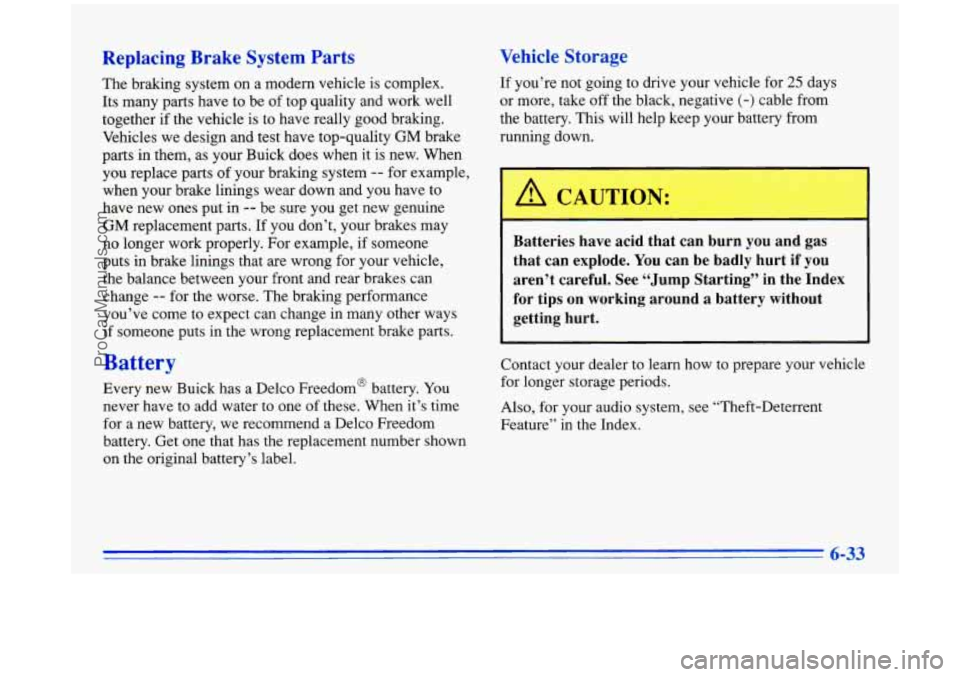
Replacing Brake System Parts
The braking system on a modern vehicle is complex.
Its many parts have to be of top quality and work well
together if the vehicle is to have really good braking.
Vehicles we design and test have top-quality
GM brake
parts in them,
as your Buick does when it is new. When
you replace parts of your braking system
-- for example,
when your brake linings wear down
and you have to
have new ones put in
-- be sure you get new genuine
GM replacement parts. If you don’t, your brakes may
no longer work properly. For example, if someone
puts in brake linings that are wrong for your vehicle,
the balance between your front and rear brakes can
change
-- for the worse. The braking performance
you’ve come to expect can change in many other ways
if someone puts
in the wrong replacement brake parts.
Battery
Every new Buick has a Delco Freedom@ battery. You
never have to add water to one of these. When it’s time
for a new battery, we recommend a Delco Freedom
battery. Get one that has the replacement number shown
on the original battery’s label.
Vehicle Storage
If you’re not going to drive your vehicle for 25 days
or more, take off the black, negative
(-) cable from
the battery. This will help keep your battery from
running down.
Batteries have acid that can burn you and gas
that can explode. You can be badly hurt if you
aren’t careful. See “Jump Starting” in the Index
for tips on working around
a battery without
getting hurt.
Contact your dealer to learn how to prepare your vehicle
for longer storage periods.
Also, for your audio system, see “Theft-Deterrent
Feature” in the Index.
ProCarManuals.com
Page 282 of 388
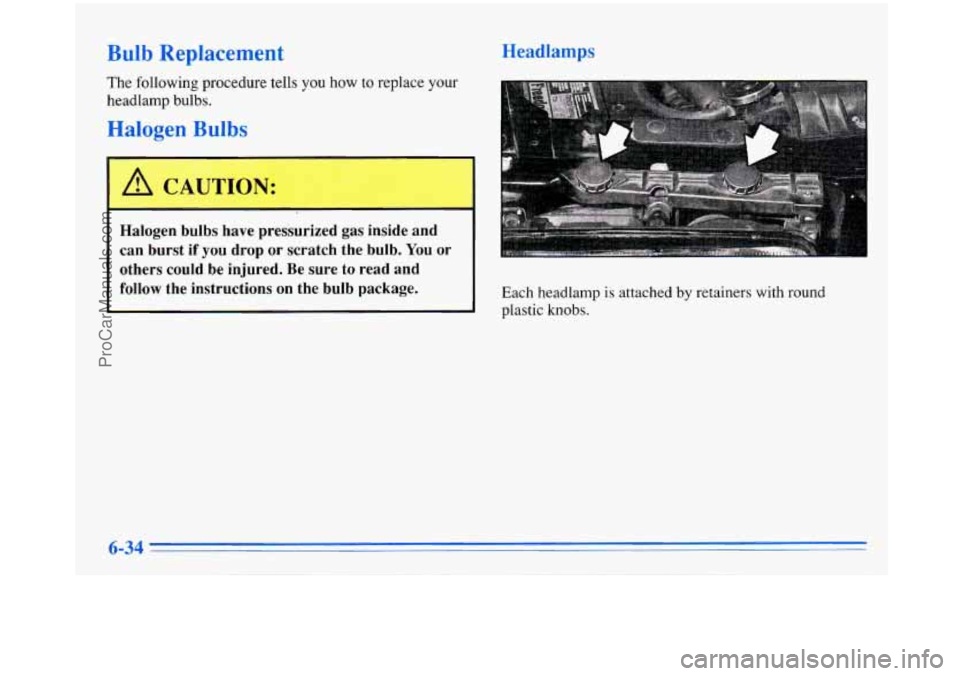
Bulb Replacement
The following procedure tells you how to replace your
headlamp bulbs.
Halogen Bulbs
Halogen bulbs have pressurized gas inside and
can burst if
you drop or scratch the bulb. You or
others
could be injured. Be sure to read and
follow the instructions on the bulb package.
Headlamps
Each headlamp is attached by retainers with round
plastic knobs.
ProCarManuals.com
Page 283 of 388
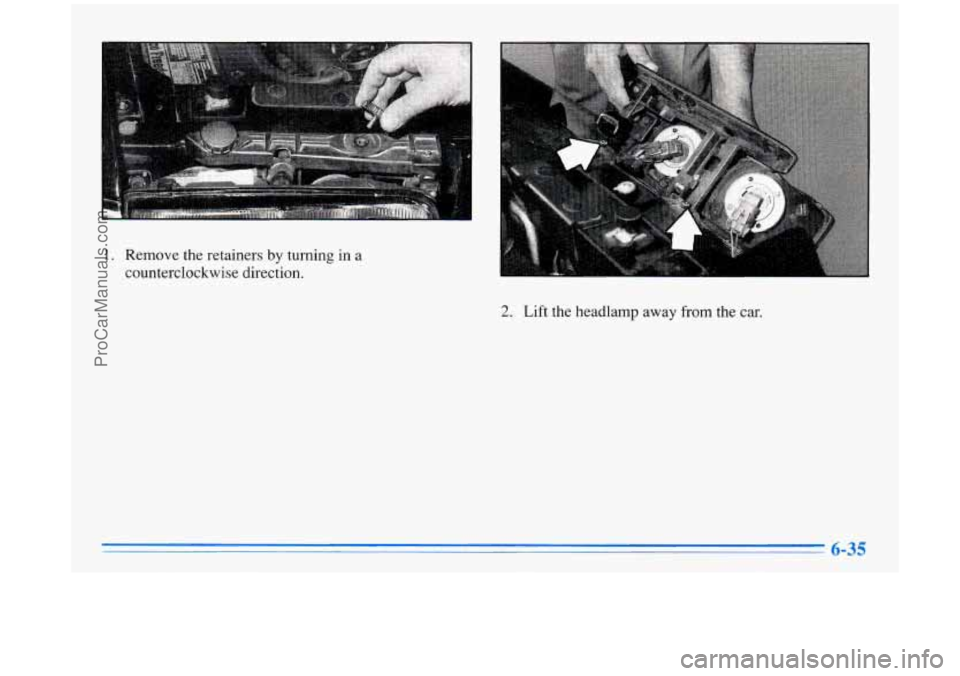
1. Remove the retainers by turning in a
counterclockwise direction.
2. Lift the headlamp away from the car.
6-35
-
ProCarManuals.com
Page 284 of 388
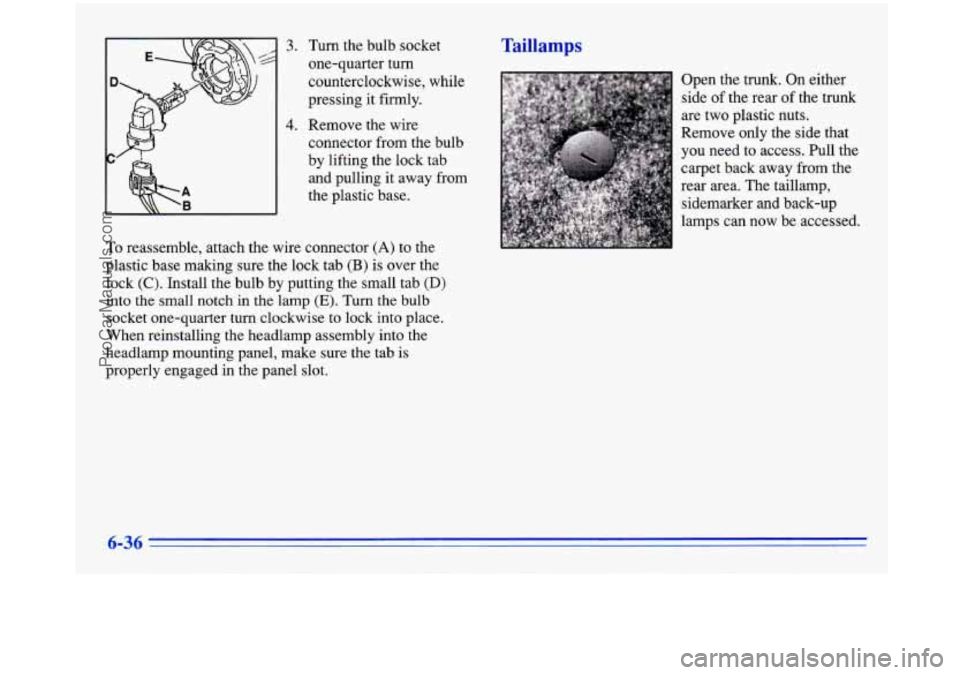
3. Turn the bulb socket
one-quarter turn
counterclockwise, while
pressing it firmly.
4. Remove the wire
connector from the bulb
by lifting the lock tab
and pulling it away from
the plastic base.
To reassemble, attach the wire connector (A) to the
plastic base making sure the lock tab
(B) is over the
lock
(C). Install the bulb by putting the small tab (D)
into the small notch in the lamp (E). Turn the bulb
socket one-quarter turn clockwise to lock into place.
When reinstalling the headlamp assembly into the
headlamp mounting panel, make sure the tab
is
properly engaged in the panel slot.
Taillamps
Open the trunk. On either
side
of the rear of the trunk
are two plastic nuts.
Remove only the side that
you need to access. Pull the
carpet back away from the
rear area. The taillamp,
sidemarker and back-up
lamps can now be accessed.
ProCarManuals.com
Page 285 of 388
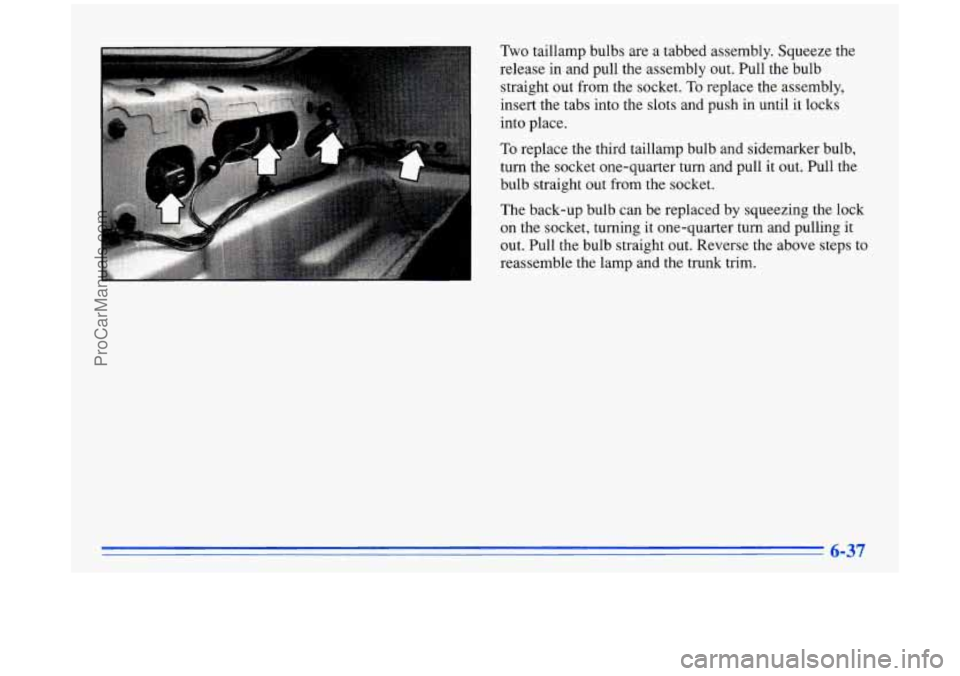
Two taillamp bulbs are a tabbed assembly. Squeeze the
release in and pull the assembly out. Pull the bulb
straight out from the socket.
To replace the assembly,
insert the tabs into the slots and push in until it locks
into place.
To replace the third taillamp bulb and sidemarker bulb,
turn the socket one-quarter turn and pull it out. Pull the
bulb straight out from the socket.
The back-up bulb can be replaced by squeezing the lock
on the socket, turning it one-quarter turn and pulling it
out. Pull the bulb straight out. Reverse the above steps to
reassemble the lamp and the trunk trim.
ProCarManuals.com
Page 286 of 388
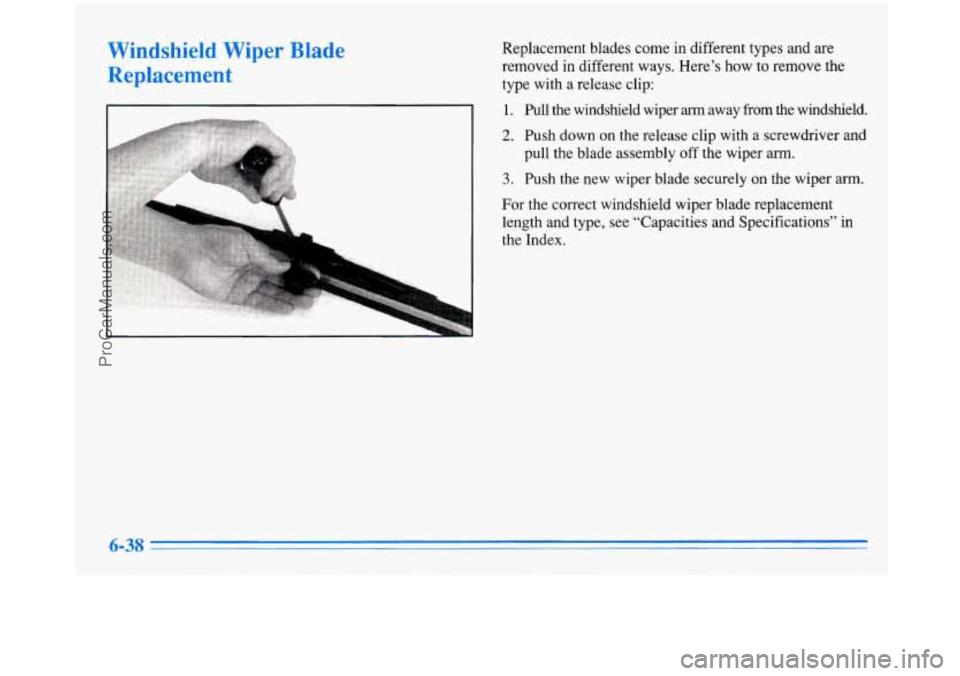
Windshield Wiper Blade
Replacement
Replacement blades come in different types and are
removed in different ways. Here’s how to remove the
type with a release clip:
1. Pull the windshield wiper arnn away from the windshield.
2. Push down on the release clip with a screwdriver and
pull the blade assembly off the wiper arm.
3. Push the new wiper blade securely on the wiper arm.
For the correct windshield wiper blade replacement
length and type, see “Capacities and Specifications’’ in
the Index.
ProCarManuals.com
Page 287 of 388
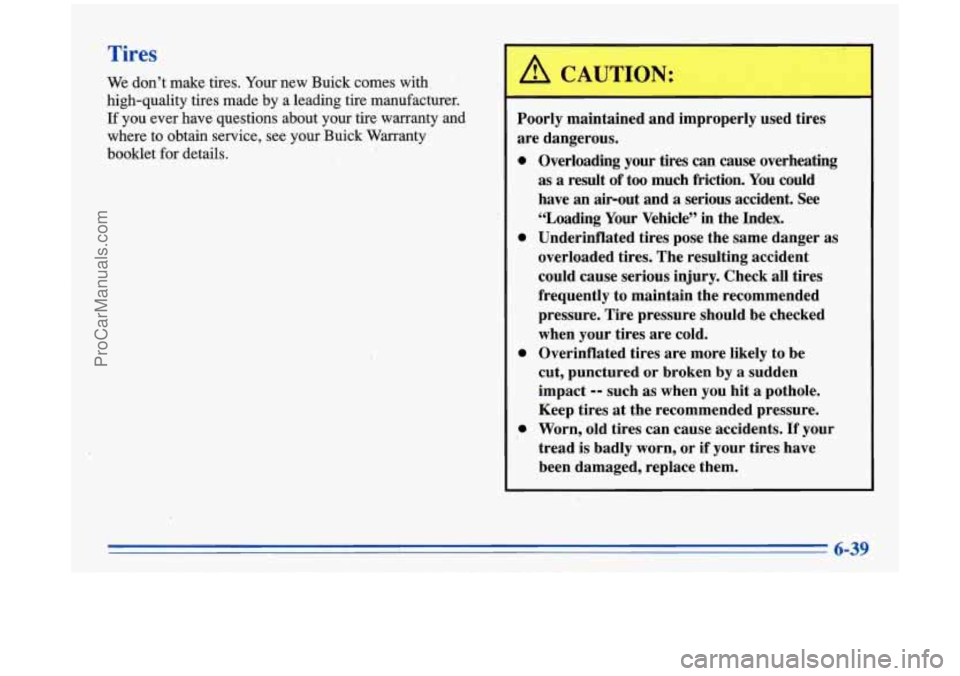
Tires
We don’t make tires. Your new Buick comes with ’
high-quality tires made by a leading tire manufacturer.
If you ever have qu,estions about your tire warranty and
where to obtain service, see your Buick Warranty
booklet for details.
A C IUTION:
-
Poorly maintained and improperly used tires
are dangerous.
0
0
Overloading your tires can cause overheating
as
a result of too much friction. You could
have
an about and a serious accident. See
“Loading Your Vehicle” in the Index.
Underinflated tires pose the same danger
as
overloaded tires. The resulting accident
could cause serious injury. Check all tires
frequently to maintain the recommended
pressure. Tire pressure should be checked
when your tires are cold.
Overinflated tires are more likely to be
cut, punctured or broken
by a sudden
impact
-- such as when you hit a pothole.
Keep tires at the recommended pressure. Worn, old tires can cause accidents.
If your
tread is badly worn, or if your tires have
been damaged, replace them.
6-39
ProCarManuals.com
Page 288 of 388
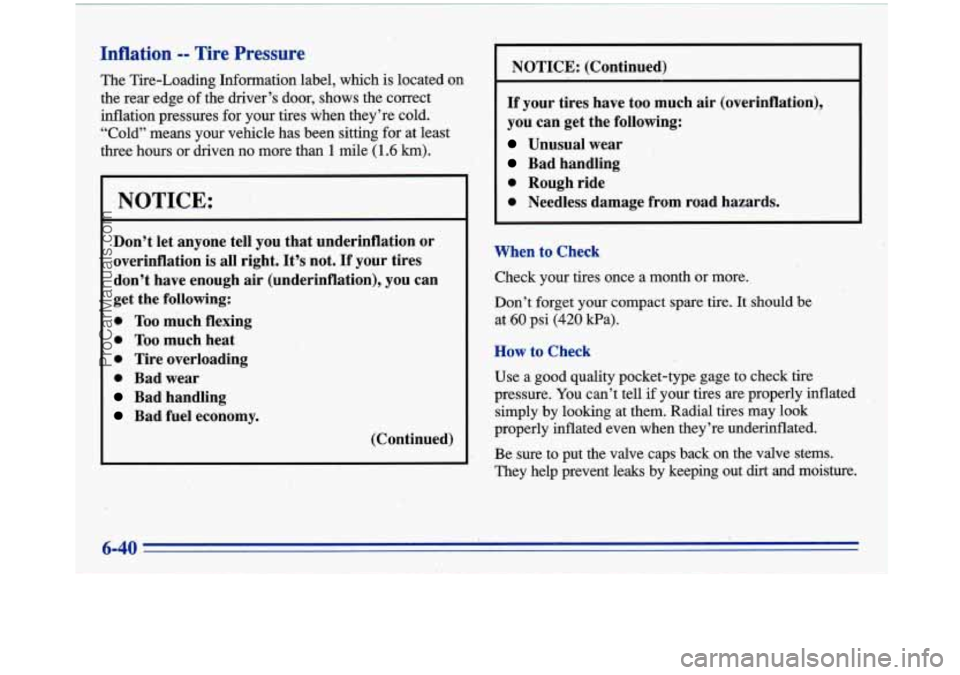
Inflation -- Tire Pressure
The Tire-Loading Information label, which is located on
the rear edge
of the driver’s door, shows the correct
inflation pressures for your tires when they’re cold.
“Cold” means your vehicle has been sittkg for at least
three hours or driven no more than
1 mile (1.6 km).
.NOTICE:
Don’t let anyone tell you that underinflation or
overinflation is all right. It’s not.
If your tires
don’t have enough air (underinflation), you can
get the following:
0 Too much flexing
0 Too much heat
0 Tire overloading
0 Bad wear
Bad handling
Bad fuel economy.
I
(Continued) NOTICE: (Continued)
If your tires have too much air (overinflation),
you can get the following:
Unusual wear
Bad handling
0 Rough ride
0 Needless damage from road hazards.
When to Check Check your tires once a month or more.
Don’t forget your compact spare tire. It should be
at
60 psi (420 Ea).
How to Check
Use a good quality pocket-type gage to check tire
pressure.
You can’t tell if your tires are properly inflated
simply by looking at them. Radial tires may look
properly inflated even when they’re underinflated.
Be sure to put the valve caps back on the valve stems.
They help prevent leaks by keeping out dik and moisture.
6-40
,
ProCarManuals.com
Page 289 of 388
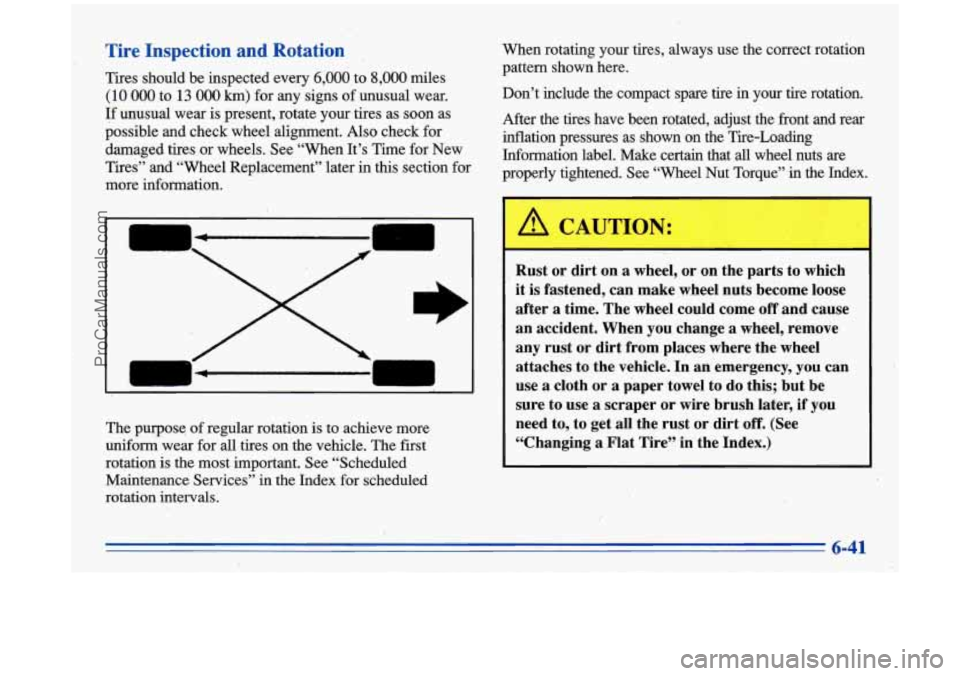
Tire Inspection and Rotation ,
Tires should be inspected every 6,000 to 8,000 miles
(10 000 to 13 000 km) for any signs of unusual wear.
If unusual wear is present, rotate yourtires as soon as
possible and check wheel alignment.
Also check for
damaged tires or wheels. See “When It’s The for New
Tires” and “Wheel Replacement” later in this section for
more information. When
rotating your tires, always use the correct rotation
pattern shown here.
Don’t include the compact spare tire in your tire rotation.
After the tires have been rotated, adjust the front and rear
inflation pressures as shown on the Tire-Loading
Information label. Make certain that
all wheel nuts are
properly tightened. See “Wheel Nut Torque”
in the Index.
I I
The purpose of regular rotation is to achieve more
uniform wear for
all tires on the vehicle. The first
rotation is the most important. See “Scheduled
Maintenance Services”
in the Index for scheduled
rotation intervals.
A CAUTION:
I
Rust or dirt on a wheel, or on the parts to which
it
is fastened, can make wheel nuts become loose
after
a time. The wheel could come off and cause
an accident. When
you change a wheel, remove
any rust or dirt from places where the wheel
attaches
to the vehicle. In an emergency, you can
use
a cloth or a paper towel to do this; but be
sure to use a scraper or wire brush later, if you
need to, to get all the rust
or dirt off. (See
“Changing
a Flat Tire” in the Index.)
6-41
ProCarManuals.com
Page 290 of 388
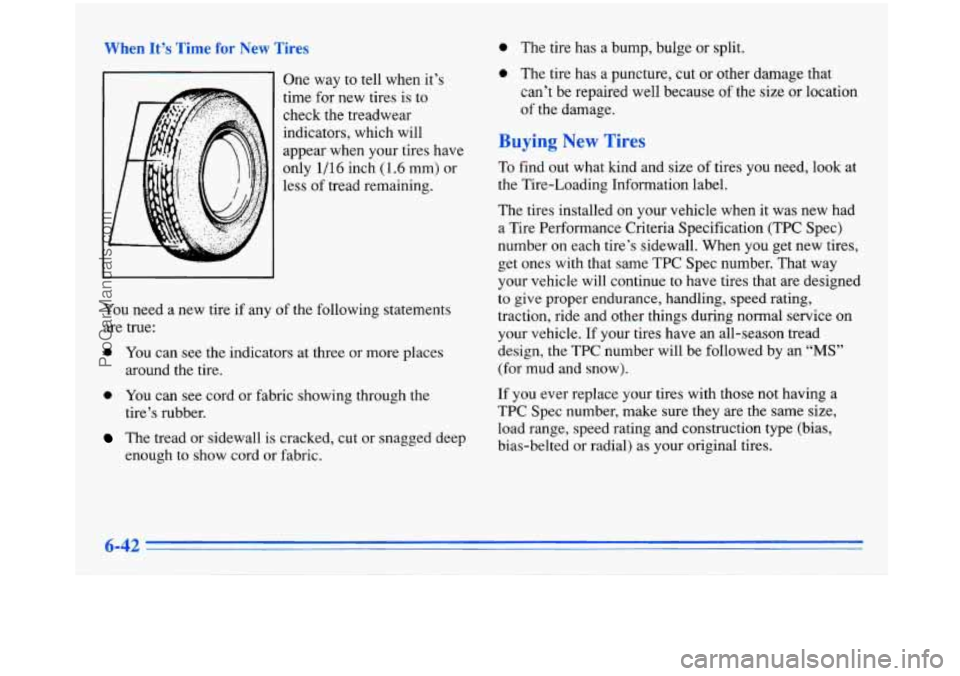
0 The tire has a bump, bulge or split.
0 The tire has a puncture, cut or other darnage that
can’t be repaired well because of the size or location
of the damage. 7 One way to tell when it’s
time for new tires is to
check the treadwear
indicators, which will
appear when your tires have
only
1/16 inch (1.6 mm) or
less of tread remaining.
You need a new tire if any of the following statements
are true:
0 You can see the indicators at three or more places
around the
tire.
0 You can see cord or fabric showing through the
tire’s rubber.
The tread or sidewall is cracked, cut or snagged deep
enough to show cord
or fabric.
uying New Til
To find out what kind and size of tires you need, look at
the Tire-Loading Information label.
The tires installed on your vehicle when it was new had
a Tire Performance Criteria Specification (TPC Spec)
number on each tire’s sidewall. When you get new tires,
get ones with that same TPC Spec number. That way
your vehicle will continue to have tires that are designed
to give proper endurance, handling, speed rating,
traction, ride and other things during normal service on
your vehicle. If your tires have an all-season tread
design, the TPC number will be followed by an
“MS”
(for mud and snow).
If you ever replace your tires with those not having
a
TPC Spec number, make sure they are the same size,
load range, speed rating and construction type (bias,
bias-belted or radial) as your original tires.
ProCarManuals.com